SOUTHERN ASTRONOMERS and
AUSTRALIAN ASTRONOMY
THE SYDNEY OBSERVATORY :
ITS HISTORY AND WORK
JAMES NANGLE, O.B.E., F.R.A.S.
President of the New South Wales Branch of the British
Astronomical Association,
Superintendent of Technical Education, and Government Astronomer.
Sydney Technical College. 1930
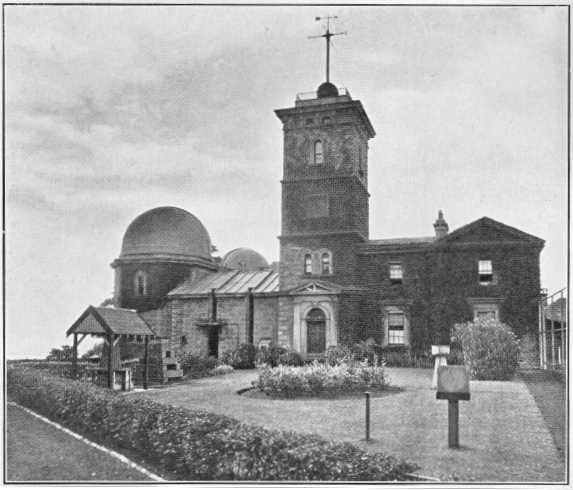
THE SYDNEY OBSERVATORY
The Southern Facade — 1930
The earliest map of Sydney, prepared shortly after the arrival
of Governor Phillip in the first Fleet during 1788, shows the
position of a small observatory near the extremity of a point on the
west side of the cove now known as Circular Quay. The observatory was
built to house the instruments provided by Dr. Maskelyne, Astronomer
Royal at the time, at whose request observations were to be made of
one of the comets selected by Dr. Halley for his researches, the
return of which was then expected. The point of land on which the
observatory was built was called after Dr. Maskelyne, but later on
its name was changed to Dawes’ Point,
after Lieutenant Dawes, in whose care the instruments were placed,
who directed the building of the observatory, and who used the
instruments in the observation of the Comet. Unfortunately, there
seem to be no records of this observatory, nor of the work done in
it, but its position was near the site of the southern pylon of the
great Bridge now being built to span the Harbour. A plate
commemorating the observatory is to be placed on the pylon.
In 1822, thirty-four years after the arrival of the first Fleet,
another observatory was established in New South Wales. This was
erected by Sir Thomas Brisbane, who, being well versed in the theory
and practice of astronomy, was attracted by the opportunities for
discovery presented by the southern sky, then but very little
known.
Dr. Halley had voyaged in 1677 to the Island of St. Helena, and
secured observations of the places of 341 southern stars, which
were published in catalogue form about a century later. The Abbe de
Lacaillé had also done some very important work at the Cape of
Good Hope in the middle of the 18th century, and observed the places
of 9,766 stars, which were tabulated and published in catalogue form
later on. But beyond the work of Halley and de Lacaillé,
practically nothing was known of the wealth of southern celestial
bodies away from the reach of observers in the Northern
Hemisphere.
Sir Thomas Brisbane brought with him two observers, Dr.
Rümker and James Dunlop, and a number of astronomical
instruments. Shortly after his arrival, the erection of an
observatory at Parramatta was completed, and observations were
commenced. The expenses of bringing out the two observers, and of the
astronomical instruments, were defrayed by Sir Thomas Brisbane from
his private purse, so that the undertaking in the interests of
science was very large-hearted on the part of this early Governor.
For some years work went on there rapidly. The places of 7,385 stars
were observed and recorded, and were afterwards published in what is
known as the Parramatta Catalogue. For this fine work the Royal
Astronomical Society of England awarded its Gold Medal to Sir Thomas
Brisbane. James Dunlop assisted with the observations of the places
of stars, and made, besides, many observations and measures of double
stars. For a catalogue of 621 nebulae and clusters, and one of 253
double stars, Dunlop was also awarded the Gold Medal of the Royal
Astronomical Society. Later on Rümker was given similar
recognition by the Royal Astronomical Society for work done at
Parramatta.
At the expiration of the term of Sir Thomas Brisbane as Governor,
and before his departure from the Colony, the Government purchased
the instruments and decided to carry on the observatory. Rümker,
who had left the Parramatta observatory, was offered the position of
Government Astronomer, and acted for about four years. He then
accepted the Directorship of the Hamburg Observatory, where later on
he distinguished himself. Dunlop, who in the meantime had travelled
to England in order to present his own catalogues to the Royal
Astronomical Society, was then offered the position, which he
accepted and held from 1831 until 1847, when, through failing health,
he was forced to resign. By this time, the Parramatta Observatory and
instruments had become out of repair, and either through lack of
funds, or want of interest in its continuance, it was decided to
abandon it and bring the instruments to Sydney, where they were
stored. The piers which supported the transit telescope at Parramatta
Observatory still exist in position, and nearby, an inscription on an
obelisk records the one-time existence of the celebrated
observatory.
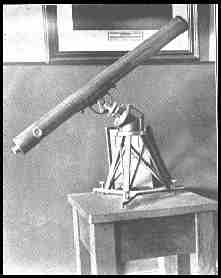
The SMALL REFRACTOR EQUATORIAL
TELESCOPE - By Banks of London
Brought to New South Wales by Sir Thomas Brisbane.
Three-and-a-quarter inches aperture and 46 inches focal length, and
mounted on a Seaton Block. it was one of the first telescopes set up
in the Southern Dome of the Sydney Observatory, having been brought
from Parramatta. It is now set up in the vestibule of Sydney
Observatory.
Without doubt, the action of Sir Thomas Brisbane in establishing
the Parramatta Observatory — the first real observatory in the
Southern Hemisphere and the work done in it, was a fine beginning for
science generally, and astronomy in particular, in the young colony
of New South Wales, and it was owing to this auspicious start that in
Sydney, and at Melbourne and Adelaide, astronomical observatories
were established, and that Australia was led thus early in its
history to take an important part among the older nations in the
practice of astronomy.
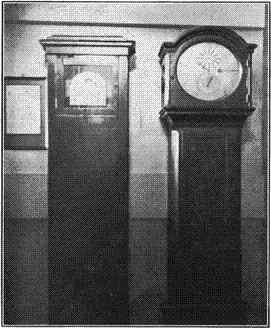
CLOCKS FROM PARRAMATTA
OBSERVATORY
The clock shown on the left is by French maker,
Breguet. This was used by Dr. Rümker in making the first
pendulum experiments in Australia. The clock on the right is the
Sidereal Clock used at Parramatta. Both clocks are still in good
order, but are not used for exact time-keeping.
From 1847 until 1855 New South Wales was without an official
observatory, though proposals to establish a system of time
determination with time signals by the dropping of a time ball were
constantly under consideration. Captain Phillip King was one of the
persistent advocates, not only for the establishment of a time
service, but for the setting up of an official observatory in which
regular astronomical work could be carried on. The idea of having the
observatory at Sydney was largely strengthened by the action of the
Royal Astronomical Society in passing a resolution strongly urging
the carrying on of astronomical work at this end of the world. It is
interesting to note that Sir John Herschel was president of the
Society and in the chair at the time when the resolution was
carried.
Sir William Denison, Governor-General, arrived in 1855, and
immediately became interested in the proposals for the observatory,
and in a spirited memorandum to the Legislative Council, urged that
immediate steps be taken to establish an observatory. Sir William
Denison pointed out the necessity for a time service, but also
stressed the value of the observatory as an aid to scientific
discovery and the dissemination of knowledge in this country. The
Legislative Council agreed, and voted a sum of £7,000 for the
erection of an observatory at Sydney, and made provision for the
salary of an astronomer and a computer. The then Astronomer-Royal,
Sir George Airy, was asked to select an astronomer, and recommended
the Rev. W. Scott, M.A. Mr. Scott was appointed, and arrived
shortly afterwards. He immediately set to work to select a site for
the proposed building. With the assistance of the Governor-General,
he selected a site known as Flagstaff Hill, almost above the
position occupied by Dawes' Observatory. The building was commenced
in 1857, and was sufficiently advanced to allow of meridian
observations being commenced in June 1859. This is the building
which still stands as the Sydney Observatory. It is a very
substantially built structure, in Sydney sandstone, designed in the
style of the Florentine Renaissance. Even originally it included a
residence for the astronomer, space for the transit instrument, a
tower surmounted by a dome for the equatorial, a room for the
computer and an office for the astronomer. From the centre of the
front of the building a tower was built 58 feet high, on the top of
which was placed a time ball. A transit circle, an equatorial
telescope with an object glass 3¼ inches aperture and 46 inches
focal length, and three astronomical clocks, all originally from the
Parramatta Observatory, were installed.
Neither the transit instrument nor the equatorial telescope were
found to be of very great value for observations. Mr. Scott was
successful in obtaining a vote from Parliament of £800 for the
purchase of an achromatic telescope, 7¼ inches aperture and 124
inches focal length, by Merz and Sons, of Munich. This instrument was
mounted and ready for use in June, 1861. Though Mr. Scott only
remained in office for four years, he made many astronomical
observations. His determination of the latitude of the Sydney
Observatory still stands. Two of the astronomical clocks, namely, one
by Breguet, and another by Hardy, still remain at the Observatory,
and are set up in the vestibule. The small equatorial telescope is
also in existence, and is also exhibited in the vestibule. As already
mentioned, the equatorial and the clocks were those brought out by
Brisbane, and used at Parramatta. Neither the docks nor the telescope
are of any use for astronomical work, but they are priceless relics
of the celebrated Parramatta Observatory.
Mr. Scott was succeeded by Mr. George Smalley, who commenced duty
in 1864. Mr. Smalley had to content himself with the determination of
time and minor astronomical observations, because he was of the
opinion that he could not do very precise work with the transit
instrument. For some time previously, the setting up of a base line,
and the carrying out of a trigonometrical survey of N.S.W. had been
advocated. Mr. Smalley wisely thought that he could best devote his
energy to the setting up of such a base line. This he proceeded to
do, and selected a site on the shores of Lake George. He met with
many difficulties in carrying out his work, and probably his health
suffered, because he died in 1870, before the base line was
completed.
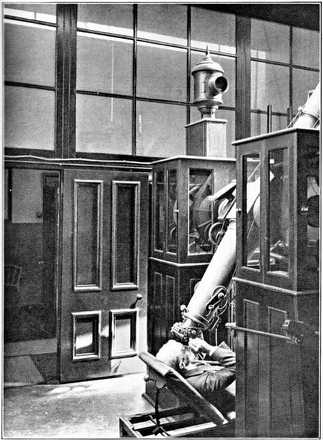
THE TRANSIT TELESCOPE AT SYDNEY OBSERVATORY
This is the most precise instrument at the
Observatory, and with it are determined star places for the Great
Catalogue. It is also used in the accurate determination of time.
He was succeeded by Mr. Henry Chamberlain Russell, who had been
computer under Mr. Scott, and later under Mr. Smalley. Mr. Russell
held the position until 1905. During this long period he did much to
advance the science of astronomy in the Southern Hemisphere, and
occupied a commanding place in the scientific life of the State.
During his directorship he completely replaced the instrumental
equipment, and made the observatory in this respect equal to many of
the first-class observatories in the Old World. In 1872, with the
assistance of the Royal Society of New South Wales, he obtained
authority from Parliament to procure a large equatorial telescope and
a first-class transit telescope. He purchased an object glass, 11.4
inches aperture and 12.5 feet focal length, from Schroeder, of
Hamburg, and designed and had constructed in the State, under his
supervision, an equatorial mounting. This telescope is still in the
southern dome, and is in good working order. It is the largest
refractor telescope in Australia, which perhaps is not saying very
much, because it is very small indeed compared with the giant
telescopes in Europe and America. The transit instrument has an
object glass of 6 inches aperture and 85 inches focal length. It has
two circles graduated to every five minutes of arc and each read by
four microscopes. This instrument was ready for use in February 1877.
It was made by Messrs. Troughton & Simms. It is a very fine
instrument, allowing of observations with the highest precision, and
with it is done most of the work carried out under the present
programme of the observatory.
In 1887 Mr. Russell went to Europe to attend the Astrophotographic
Congress at Paris, as representative of the Governments of New South
Wales and Victoria. At the Conference, he pledged the Sydney and
Melbourne Observatories to undertake a share in the preparation of
the great Astrographic Catalogue and Chart. Sydney was allotted that
part of the sky ranging between 52° and 65° of south
declination. On his return, Mr. Russell immediately set about
starting the Sydney portion of the work. He procured a photographic
object glass from Steinheil, of Munich, and had the mounting, with
all the requisite accessories, made here to his own design. A
circular wooden observatory detached from the main building was
specially built to house this instrument. The astrograph, as it was
called, was ready for use for work connected with the Astrographic
Catalogue in 1891.
The increase of artificial light in the city interfered with
photography so much that it was decided to remove the Astrograph to
Pennant Hills, which was done in 1899. Since that time the
photography for the Catalogue and Chart has been carried out at that
branch observatory.
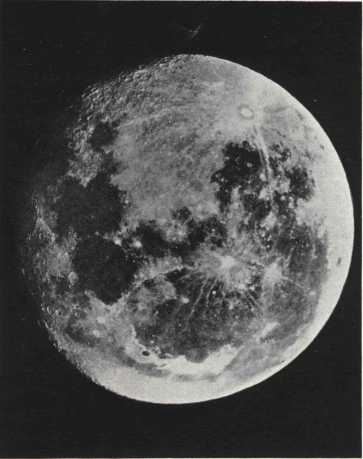
PHOTOGRAPH OF THE MOON
Taken at Sydney Observatory
by the late Mr. H.C. Russell
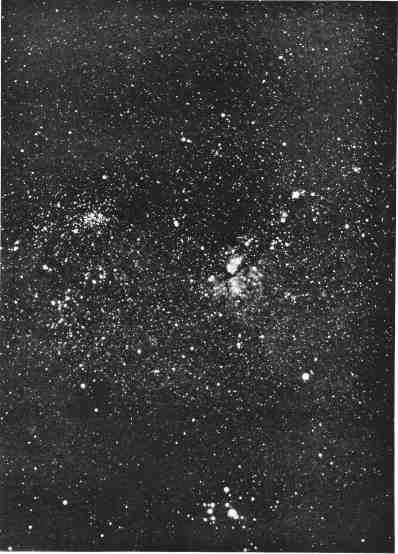
PHOTOGRAPH OF THE CELEBRATED KEYHOLE NEBULA
ABOUT ETA ARGUS
Taken at Sydney Observatory
by the late H.C.Russell
Mr. Russell greatly distinguished himself by the magnificent star
and lunar photographs which he secured as a result of his experiments
at the Sydney Observatory. He also made many observations of double
stars, which were published. In addition to his great activities in
the science of astronomy, Mr. Russell worked continuously towards the
advancement of meteorology in this country. From the time of its
establishment, meteorological observations were made at the Sydney
Observatory. When Mr. Russell became Director, he reorganised the
system of observations and did much towards developing a theory which
he held that there was a definite periodicity in the droughts in this
country. He also invented many instruments which were used in
meteorological observations.
Mr. Alfred Henry Lenehan was appointed Government Astronomer as
successor to Mr. Russell. Under his direction the routine programme
of previous years and work on the photographic catalogue was carried
on as previously. He died on the 2nd May, 1908. From the time of his
death, until 1912, Mr. W. E. Raymond acted as Officer-in-Charge. In
1912 Mr. W. E. Cooke, formerly director of the Perth Observatory, was
appointed Government Astronomer and also Professor of Astronomy at
the Sydney University. Professor Cooke was convinced that the
Observatory should be removed to a more suitable site, and that more
modern equipment should be obtained. His attempts to get a new
observatory established were unsuccessful, and he decided to set to
work with the equipment available. The preparation of a catalogue of
1,068 intermediate stars was completed and published by 1920. He
proceeded with commendable rapidity with the photographic observation
and reduction of plate stars and publication. When he retired in 1927
he had published six volumes of the Star Catalogue. Professor Cooke
greatly distinguished himself through the improvements which he was
successful in having carried out in the method of observing and
reducing the plate stars necessary to the preparation of the
Catalogue. At the time of Professor
Cooke’s retirement, the Government of
the day decided to close the Observatory. Great objection to the
proposed action was taken by the University and by the scientific
societies in the State, with the result that it was decided to
continue the observatory, but with a very much reduced staff. The
Government was more ready agree to its continuance because of the
necessity to maintain a time service and to secure a supply of
astronomical information necessary for civil purposes. The
Observatory was transferred to the Department of Technical Education,
and the writer was made immediately responsible for direction. The
whole of the buildings, including the
Astronomer’s residence, were completely
renovated, and the equatorial telescopes and other instruments were
put in good order. Since then the routine work of the Observatory has
been carried out successfully, and work has proceeded steadily with
the Star Catalogue. Since the Observatory was transferred to the
present Director, four volumes of the Star Catalogue have been
published.
Sir George Airy, Astronomer-Royal of England was much interested
in the future of the observatory to be established in Sydney, and set
forth for the guidance of Mr. Scott his views what its objectives
should be. His description of what should be done in a national
Observatory was very inspiring at the time, and is still so to anyone
interested in the advancement of astronomy. It is to be regretted
that space will not allow of its being quoted in full, but it may be
mentioned that Sir George Airy pointed out that the Observatory
should be a source of all information of an astronomical character
required for civil purposes; that it should be engaged in active
research in some branch of astronomy, and that it should be a centre
from which would radiate an educational influence that would help to
improve the general culture of the community. It is very pleasing to
find that, commencing with Mr. Scott, all the Directors some,
perhaps, more than others have steadfastly kept in view the ideals
set forth by Sir George Airy, with the result that the Sydney
Observatory has been carried on in accordance with a programme of
three very definite objectives.
In the first place, it has to supply information based on
astronomical observation and computation for civil purposes,
including the determination of time, preparation of information for
the daily press of times of sunrise and sunset, phases of and times
of rising and setting of the moon, and memoranda connected with the
major planets. It is astonishing how much information is continually
required, by the legal and commercial community especially, about the
position of either the sun or the moon at particular times.
Furthermore, the Press looks to the Observatory for explanation of
phenomena which continually occurs, and for opinions about
astronomical discoveries, news of which is received very frequently
from other parts of the world. There is also a wide range of
inquiries from the public. The time must be determined each, day by
the use of the transit instrument, with the utmost accuracy, and
transmitted by wire and wireless over the State. The time ball at the
top of the tower is dropped automatically, through apparatus in the
Mean Time Clock, exactly at 1 p.m. every weekday. The wireless time
signals are transmitted, also automatically, from the Mean Time
Clock, through VIS Radio Station at Pennant Hills, from 12.55 p.m. to
1.00 p.m., and from 8.55 p.m. to 9 p.m. each day.
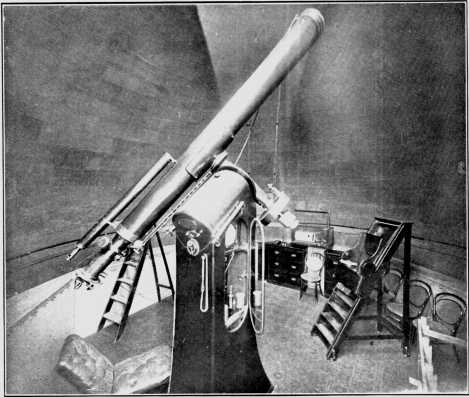
11.4 REFRACTOR EQUATORIAL TELESCOPE
In the South Dome
of Sydney Observatory
At the Observatory is installed a seismograph, which automatically
records earth tremors and earthquakes happening in different parts of
the world. Records of occurrences of this kind are reduced, and
returns are forwarded to the Central Bureau in Europe. In this way
the Sydney Observatory is taking a definite part in a worldwide
organisation for the observation and study of earthquakes.
The second purpose is the pursuit of some definite, original
scientific work. This end is being successfully aimed at in the
work which has been, and is still carried on in the preparation of
the New South Wales quota of the Star Catalogue. It is not easy to
explain so that everybody may immediately understand the value of
astronomical observation and all that is involved in trying to
understand the relationship of our little earth with the millions of
suns visible in our universe and in the universes beyond. It ought,
however, to be easy to realise that the human mind is immediately
benefited, if only in its sense of proportion, by the knowledge that
is now possessed of the distances, motions and physical properties of
the stars, and the vastness of the systems in which they move. It is
through the science of astronomy that we have gained this knowledge
and rid ourselves of narrow-mindedness and superstitions, which, at
least, were the cause of much unhappiness. It is also easy to show
that much of the routine of daily life depends for its organisation
on our knowledge of astronomy. Measures of time, surveying and map
making, and navigation are all matters of practical astronomy, and
the degree of accuracy reached in each of these departments of
activity depends entirely on our knowledge of astronomy, so that our
material as well as our spiritual needs are ministered to by those
who use telescopes and who study the meaning of what is observed. On
the other hand, the needs of astronomers have been such as to
continually stimulate the study and advancement of the supporting
sciences of mathematics and physics. Both of these sciences have
found their highest application in the solution of astronomical
problems, and have advanced as astronomy has needed them. It is
reserved for the few to make the great and spectacular discoveries
that mark epochs in the history of astronomy, but discoveries of this
kind depend entirely upon the accumulation of vast quantities of data
secured by patient and unostentatious observation. The preparation of
the great photographic Star Catalogue is a fine example of work of
this kind. The purpose in view in preparing this great Catalogue is
to measure accurately the present positions of millions of stars, in
order that astronomers in the future may be able to discover changes,
and so arrive at solutions of some of the greater outstanding
problems that confront us. Every part of the work involved in
preparing it must be done with meticulous accuracy, but it is,
nevertheless, dull and uninteresting, and requires great devotion on
the part of those carrying it out. It was estimated by the late
Professor Turner that each of the eighteen observatories of which
Sydney is one engaged in the work would have to measure on the
average at least 500,000 star images. The reduction of each of the
measures involves the use of many figures, so that each observatory
will literally use millions of figures in carrying out its part of
the undertaking. The work necessarily extends over many years. The
Sydney Observatory is yet quite a long way from completing its share,
but it is gratifying to be able to claim that it is steadily
progressing with its work, and that each portion of the work
completed is something secured in the way of valuable data for the
use of future generations of astronomers.
The third purpose is to minister towards the increase of general
scientific knowledge in the community, and very specially so in
regard to astronomy. In order that the public may have an opportunity
of having a first hand acquaintance with the most prominent objects
in the heavens, the Observatory is open to visitors every Tuesday
night on written application to the Government Astronomer. If the sky
is clear visitors are given an opportunity of looking through one of
the telescopes under the direction of a capable assistant astronomer.
If the night be cloudy a lecture, always illustrated with lantern
slides, is given and explanations about the use of the various
instruments are also made available. This privilege is much
appreciated by the public. The attendance annually is about 600, and
applications for permission to attend are always accumulating. In
addition to this, demonstrations are given annually to students from
the University and from the Teachers’
College. The Director makes it a point to frequently deliver public
lectures dealing with some branch of astronomy. These lectures are
given at various centres throughout the city and suburbs. The monthly
meetings of the New South Wales Branch of the British Astronomical
Association are held in the Library of the Observatory.
Connected with the Observatory is an advisory body known as the
Board of Visitors. The members of the board are leading scientists,
who meet periodically and are consulted by the Government Astronomer
on all matters relating to the work of the Observatory.
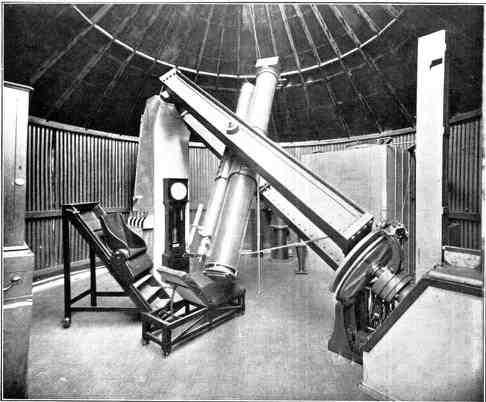
THE ASTROGRAPH
At the branch Observatory at Pennant Hills. This is a telescope
fitted with a camera, which is used to take Star Photographs for
the Great Astrographic Catalogue. It is very rigidly mounted in the
English style. The guiding telescope at the side of the large tube
is the 7¼-inch Merz refractor, purchased during the time when
Mr. Scott was Government Astronomer.
|
The Sydney Observatory is a very interesting place. It is on a
fine site and very attractive in appearance. It is full of
interesting relics of the past, and is sufficiently well equipped
to do useful scientific work. Moreover, it possesses an exceedingly
valuable library of astronomical literature. There are very few
libraries in this country possessing such complete copies of most
of the celebrated astronomical publications. It is very unfortunate
that, commencing as far back as the time when Mr. Smalley was
Director, there have been proposals continuously for its removal to
a better site. Undoubtedly an astronomical observatory should be
situated in the country, and in a climate most suitable for
observation. On the other hand, in order to meet civil needs, the
Observatory should be easily accessible, and for educational
purposes there is a definite advantage in having it in a populous
centre. Owing to the introduction of electrical power, there is not
nearly so much. smoke in the atmosphere as formerly, but the amount
of artificial light has certainly increased. Experience shows that
during the early hours of the morning the skies are quite clear,
and, excepting for photographic work, provide conditions
sufficiently satisfactory for useful astronomical observation. In
view of the circumstances, it should be continued, because it is a
very useful institution, providing necessary information for civil
purposes, taking a useful part in a great International
Astronomical Programme, and is also of great value as a means of
disseminating a knowledge of astronomy in the community. The time
may come when there will be sufficient funds to remove it to a
better, but not necessarily inaccessible, position. It may occur to
some that because there is a great National Observatory at Canberra
there is no necessity to carry on observatories in the different
States. Such an impression would be quite wrong, because there is
plenty of work for as many observatories as can be efficiently
carried on. The Observatory at Canberra is devoted to Solar and Astro
Physics. The Sydney Observatory is an institution engaged in what is
known as Positional Astronomy, that is, the accurate determination of
the Star Places. The Observatories in the other States have also
their own special programmes. Moreover, for educational purposes,
there should be a well-equipped observatory in every capital city of
the Commonwealth.
Minor Modifications : 28 December 2002
Minor Modifications : 22 April 2005
Images Added : 08 May 2006
Last Update : 23rd October 2013
Southern Astronomical Delights ©
(2012)
For any problems with this Website or Document please e-mail
me.
|











